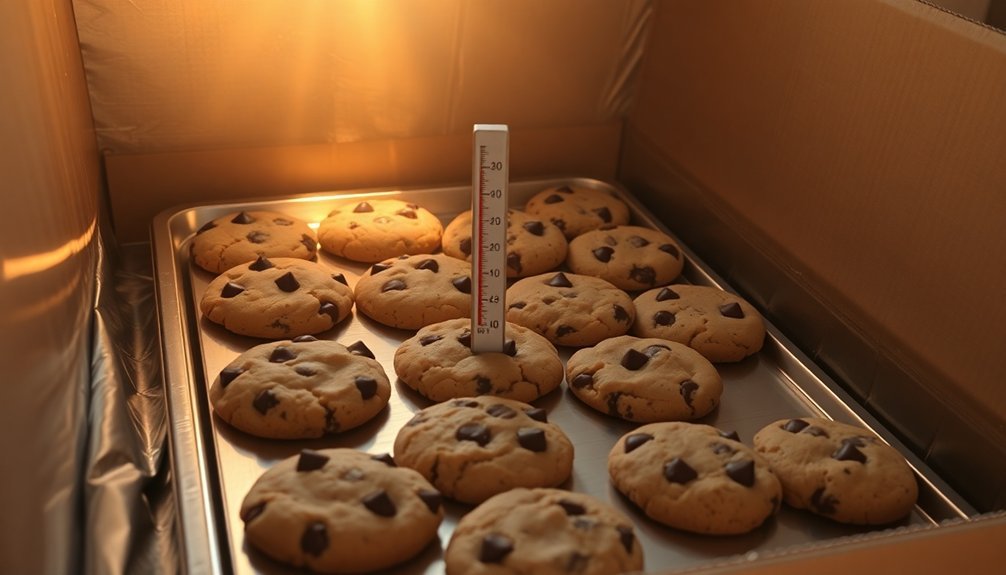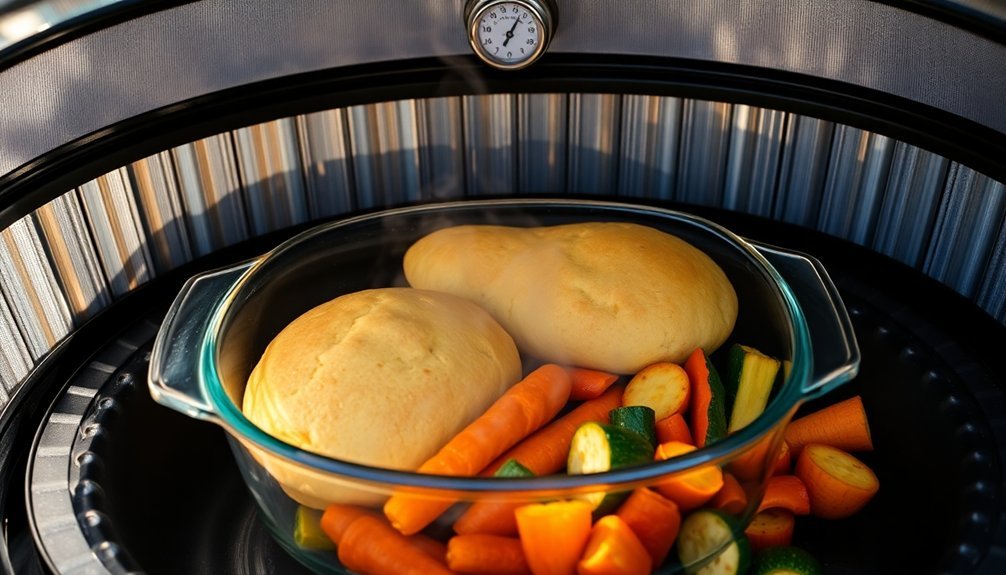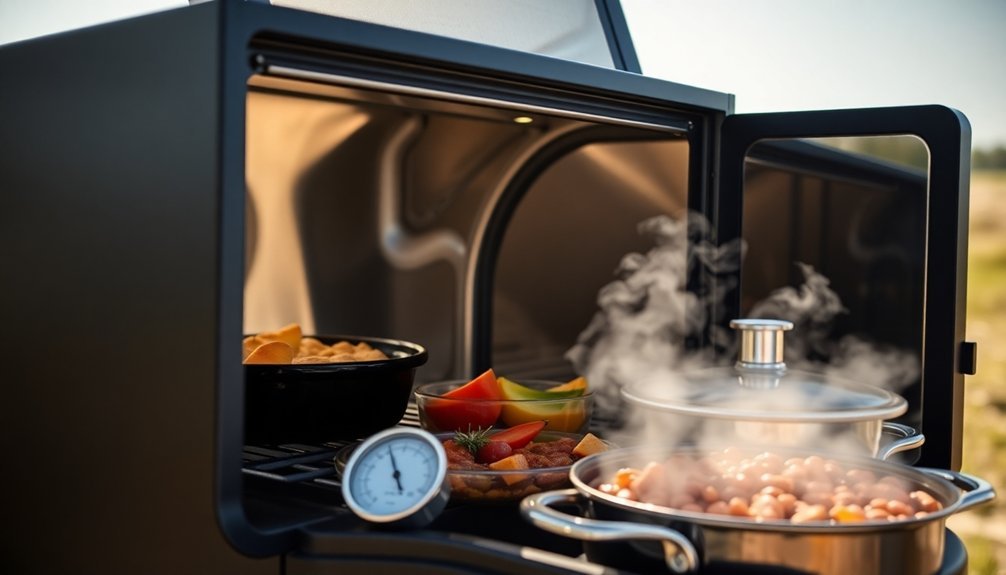You can cook a surprising variety of dishes in a solar oven, from one-pot meals like enchiladas and rice dishes to tender slow-cooked meats and even baked goods. Using dark-colored cookware between 11 am and 3 pm on sunny days, you'll achieve the best results for roasted vegetables, stews, soups, and delicious desserts like fruit crisps. While cooking times typically double compared to conventional ovens, the process is energy-efficient and maintains food's moisture and flavor. With proper equipment, positioning, and timing, you'll discover how this eco-friendly cooking method can transform your outdoor culinary adventures.
Getting Started With Solar Cooking

Curiosity about solar cooking often begins with understanding its fundamental principles. You'll need to grasp how sunlight transforms into heat energy and how reflective surfaces concentrate this energy into a cooking chamber.
The process starts with selecting an appropriate location and setting up your solar oven where it'll receive direct sunlight, ideally between 10 am and 4 pm. This method of cooking is completely sustainable energy, relying solely on the power of the sun.
Before you start cooking, you'll want to preheat your solar oven by placing it in direct sunlight for up to an hour. During this time, make sure you're using the right cookware – dark-colored pots and pans work best as they absorb heat more effectively.
You'll also need to position the reflectors to capture maximum sunlight and use an oven thermometer to monitor the temperature.
Safety is essential when you're getting started. Don't look directly at the sun while adjusting your oven, and be careful not to touch hot surfaces.
For your first attempts, choose simple recipes like cookies, roasted vegetables, or small pizzas. You'll need to rotate solid foods every 10-15 minutes and stir liquids every 10 minutes for even cooking.
Popular One-Pot Solar Meals
You'll love making easy slow-cooked enchiladas in your solar oven by layering tortillas, sauce, cheese, and your favorite fillings in a dark-colored baking dish.
Solar-ready rice dishes work wonderfully as one-pot meals when you combine rice with vegetables, proteins, and seasonings of your choice.
Both these dishes showcase how simple ingredients can transform into flavorful meals while using the sun's free energy. Traditional French dishes like Basque chicken can simmer beautifully in your solar cooker, combining tomatoes and peppers with tender chicken pieces for a Mediterranean-inspired feast.
Easy Slow-Cooked Enchiladas
Delicious enchiladas don't require a traditional oven to achieve mouth-watering results. Using a solar oven, you can create flavorful enchiladas while harnessing the sun's natural energy.
Start by combining black beans, corn, diced red onion, chopped tomato, cilantro, and olive oil in a large bowl. Let this mixture marinate in your refrigerator for at least an hour.
Then, stir in half of the enchilada sauce to create your filling. Roll this mixture into six whole wheat or corn tortillas and place them in a covered glass casserole dish. Pour the remaining sauce over your rolled enchiladas and top with shredded cheddar cheese.
Your solar oven should reach between 250-350 degrees Fahrenheit, depending on whether you're using a commercial or DIY model. Since solar ovens cook best with dark-colored pots, using a dark casserole dish helps convert sunlight into heat more efficiently. Place your dark-colored casserole dish in direct sunlight, making sure to refocus the oven every 30 minutes for ideal heating.
You'll know your enchiladas are ready when the cheese has melted and the filling is heated through, typically after about 30 minutes. Keep the lid on to retain heat and moisture, only checking occasionally to monitor progress.
Solar-Ready Rice Dishes
Rice dishes make perfect candidates for solar cooking, offering both simplicity and reliability when prepared in a sun-powered oven. You'll find that basic solar-steamed rice requires just rice and water in a 1:1 ratio, though you'll need to add extra water to compensate for the slower heating process.
Whether you're using Japanese round rice, Thai rice, jasmine, or basmati, expect cooking times of 20-30 minutes in a parabolic solar cooker like the SunGlobe.
For a more elaborate dish, try solar-cooked rice pudding. Start with partially cooked rice, then blend it with half and half, sugar, vanilla essence, and nutmeg. You'll need to temper the eggs with the warm mixture before the final 30-minute bake at 350°F in an oven-proof bowl.
Remember that solar cooking times can vary considerably based on weather conditions and temperature. You'll want to monitor your rice closely and use appropriate cookware that can withstand solar temperatures.
For best results, seal your cooking container well to create a greenhouse effect, and position your solar oven to maximize sun exposure throughout the cooking process.
Essential Solar Cooking Equipment

Getting started with solar cooking requires specific equipment designed to harness and retain the sun's energy effectively.
You'll need two cardboard boxes – one smaller than the other – to create the basic structure, along with aluminum foil for reflecting sunlight and clear plastic wrap or a window to trap heat inside.
Black construction paper or paint is essential for heat absorption, while newspapers serve as insulation between the boxes.
For ideal cooking results, you'll want to gather these essential tools:
- Dark-colored cooking vessels like black pots with lids that absorb solar radiation efficiently and maintain consistent temperatures
- Heavy-duty plastic bags and glass dishes for different food types – bags work well for liquids, while glass dishes are perfect for solid foods
- Reflective panels or foil-covered flaps that direct additional sunlight into your cooking chamber
Don't forget safety equipment – you'll need a reliable thermometer to monitor internal temperatures and oven mitts for handling hot containers.
Keep utility knives or scissors handy for construction and modifications, and consider using glue to secure components for a more durable setup.
Best Times for Solar Cooking
Successful solar cooking depends heavily on timing and seasonal patterns. You'll find the most effective cooking window between 11:00 am and 3:00 pm when the sun's position is most direct. During summer months, you can extend this window from 10:00 am to 4:00 pm, giving you more flexibility with your cooking schedule.
| Season | Peak Hours | Adjustment Needs |
|---|---|---|
| Summer | 10am-4pm | Minimal adjustments |
| Spring/Fall | 11am-3pm | Regular tracking |
| Winter | 11am-3pm | Frequent tracking |
Weather conditions considerably impact your cooking success. On sunny days, you'll achieve the highest temperatures and fastest cooking times. While partly sunny conditions still work, you'll need to extend cooking times. For cloudy days, consider using a tubular solar oven, which maintains heat more efficiently.
To maximize your solar cooking results, plan your meals around peak sun hours. Reserve the strongest sunlight for baking bread and cakes, while using lower-temperature periods for slow-cooking stews and soups. If you can't complete cooking in one session, refrigerate partially cooked items and finish them the next day during ideal sun conditions.
Safety While Solar Cooking

While mastering the timing of solar cooking is important, understanding proper safety protocols can mean the difference between a safe, enjoyable meal and potential hazards.
You'll need to position your solar oven in a safe location away from flammable materials and keep an eye on it throughout the cooking process.
Food safety is essential when using a solar oven. Always use a reliable digital probe thermometer to guarantee meats reach proper internal temperatures: 145°F for whole cuts, 160°F for ground meats, and 165°F for poultry.
Don't reuse plates or utensils that have touched raw meat, and wash your hands frequently during food preparation.
Your equipment choices matter considerably for safety. Use only food-safe cookware and avoid non-food-grade plastics that could leach chemicals into your meals.
Regular temperature monitoring between 200-300°F guarantees both safety and ideal cooking results.
- Maintain a clear 3-foot perimeter around your solar oven free of dry grass, leaves, and flammable materials
- Keep cooking vessels covered with proper lids to trap heat and prevent contamination
- Always use heat-resistant gloves when handling hot cookware, even if the ambient temperature seems cool
Solar Cooking Success Tips
To achieve the best results with solar cooking, mastering a few essential techniques can transform your outdoor culinary experience.
Start by cooking during peak hours between 11 am and 3 pm, and pre-heat your solar oven for up to an hour in direct sunlight to reach ideal temperatures of 200-300°F.
Choose dark-colored cookware, particularly black metal pans or dark brown glass dishes, as they absorb heat more effectively.
For dishes requiring stirring, black cast iron works best, while lidded pans help retain moisture when roasting vegetables. You'll want to marinate meats beforehand for better flavor and tenderness.
Position your solar oven in full sun and adjust the reflectors to focus sunlight onto the cooking chamber.
You'll need to reposition the oven periodically to follow the sun's path. Make sure your foil-covered flap directs light through the plastic-covered window effectively.
Monitor your cooking progress using an oven thermometer, and remember to stir liquids every 10 minutes while rotating solid foods every 10-15 minutes.
Keep dishes covered to maintain heat and moisture, and don't forget that cooking times typically double compared to conventional ovens.
Frequently Asked Questions
Can Solar Ovens Work in Cold Weather if There's Direct Sunlight?
Yes, you'll find that solar ovens work effectively in cold weather with direct sunlight, especially when you've properly insulated them. They can reach up to 350°F between 11am-3pm, though cooking times may be longer.
How Long Can Food Stay Warm in a Solar Oven?
Your food can stay warm for several hours in a solar oven. As long as there's direct sunlight, it'll maintain heat between 300-400°F in box ovens, while parabolic cookers reach even higher temperatures.
Does Food Cooked in Solar Ovens Taste Different From Conventional Cooking?
Yes, you'll notice a unique taste in solar-cooked food. It's often more flavorful because of slow, gentle cooking and limited air circulation. Many people say they can taste the food's natural flavors better.
Can You Use Aluminum Foil Pans Instead of Dark-Colored Cookware?
You shouldn't use aluminum foil pans since they reflect sunlight away from your food instead of absorbing it. You'll get much better results using dark-colored or black cookware that absorbs and retains heat efficiently.
What Happens if Clouds Appear Halfway Through Cooking?
If clouds appear while you're cooking, your solar oven's temperature will drop. You'll need to extend cooking time, reposition the oven for ideal sunlight, and check food temperatures regularly to guarantee proper cooking.
In Summary
You'll find solar cooking surprisingly versatile once you've mastered the basics. From baking bread and cookies to slow-cooking stews and casseroles, your solar oven can handle most dishes that work in a conventional oven. Remember to plan ahead for weather conditions and cooking times, keep your safety gear handy, and start with simple recipes. With practice and patience, you'll soon be creating delicious, sun-powered meals.





Leave a Reply